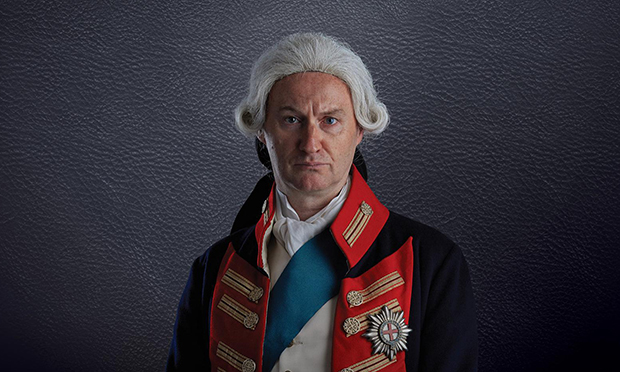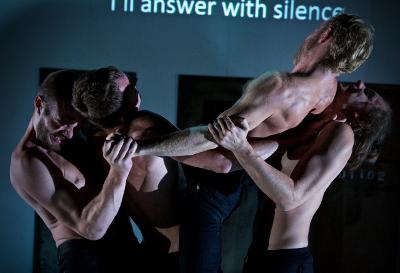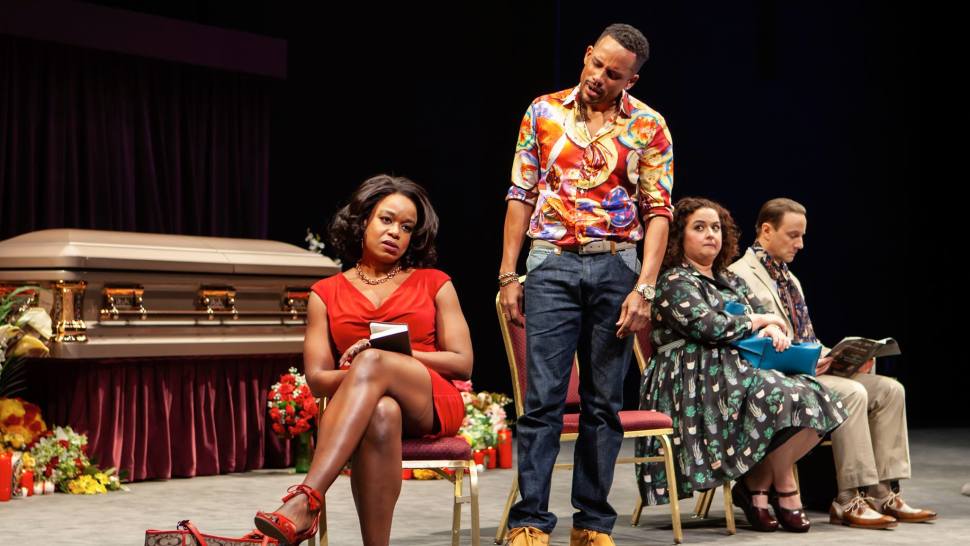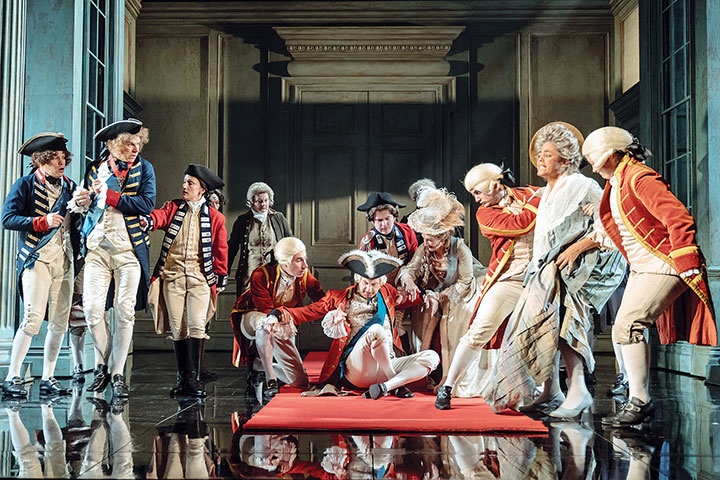
by Hazen Cuyler
The National Theatre at Home series continues their YouTube presentations throughout July, but I’ll be stepping away for just a few weeks to focus on my work within The Greenhouse Ensemble. Critiquing digital theatre is rewarding and I’m looking forward to jumping in again soon. The National’s latest production is The Madness of George III by Alan Bennett. Directed by Adam Penford, it streams on YouTube through June 18.
Longer than anyone before him, King George III reigned over England for nearly 60 years. When George experiences severe abdominal pains, his resident doctor recommends a precise dose of medicine. Ignoring that recommended dosage, he drinks to outrageous excess and goes mad. His ailment presents his son (George IV) a window through which to seize power with the help of Parliament.
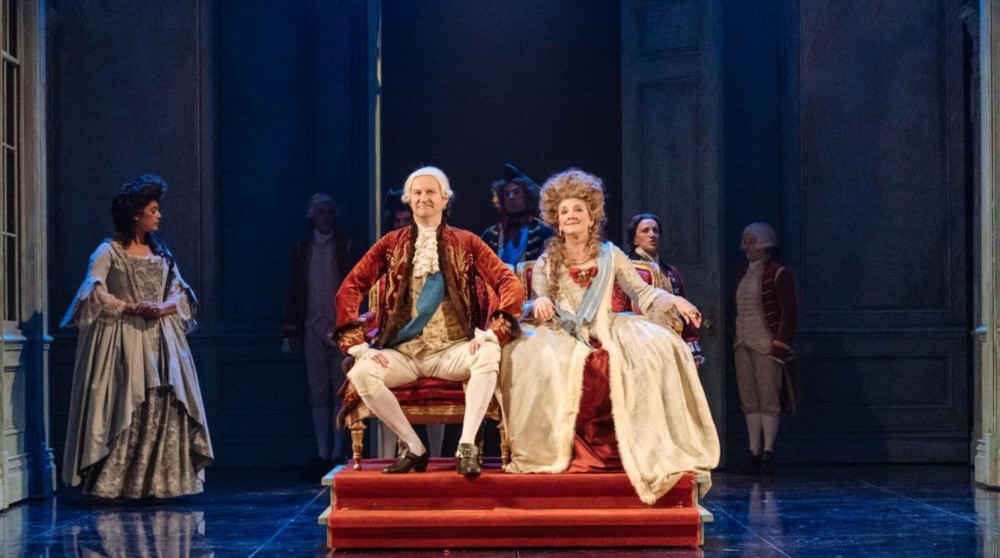

Alan Bennet’s script follows a merry (yet resentful) and arrogant ruler’s journey through an abrupt mental crisis. Mr. Bennet’s bouncy dialogue flutters with blunt playfulness. In the opening scene, George introduces us to his trustworthy colleague, Mr. Pitt. “Yes, you. What, what? You’re my Prime Minister. I chose you. Anything happens to me you’ll be out, what, what, and Mr. Fox will be in. Hey, hey.” Mark Gatiss’ vocal buoyancy and pompous charm brings our King to life. Any time George is on stage, we revel in satisfaction, relieved to find a self-important leader who happens to be a work of fiction.
Transitioning from health through sickness, Mr. Gatiss’ body takes on extremes. When we meet George, he is upright, well formed and perfectly in control of himself and his subjects. At the height of his illness, he battles writhing muscles and compulsively spurts out unintelligible rants. His barbaric doctors torture him with unconscionable procedures while Mr. Gatiss howls in pain. Torn from his wife, he sobs like a baby, cradled in a rustic wheelchair.
Set in Windsor Palace, Kew Palace and Parliament, Madness’ deliberately shabby appearance (designed by Robert Jones) is peculiar. Aged, chipped and fading green walls evoke a long-since abandoned home—a puzzling residence for the King of England. Furthering our disconnection, the play’s designed settings rarely suggest any unique location and most scenes appear practically indistinguishable from one another. Although walls are rearranged—with a fireplace added here and multiple doors added there—most configurations remain so empty in feeling and unused by actors that they may as well be painted backdrops.
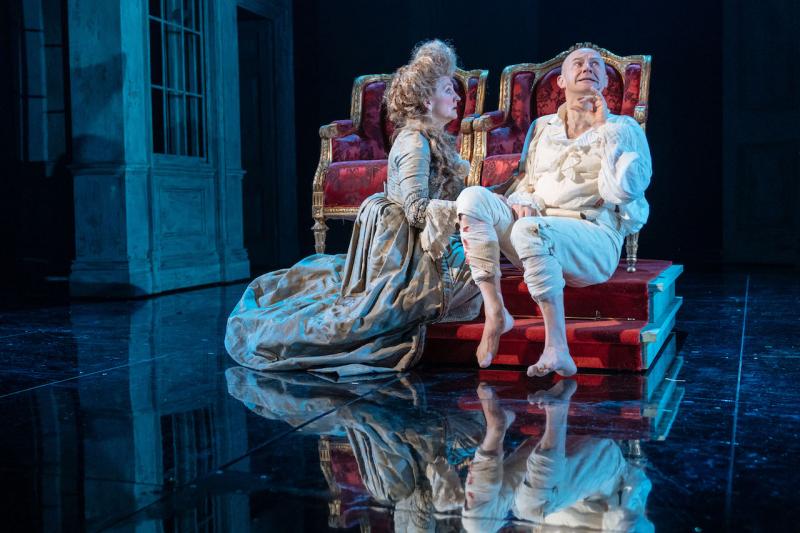

Madness’ vapid set negatively affects actors who, without a clear connection to place, often appear arranged like cardboard cutouts. Three doctors debate potential remedies for the King. They stand side by side in a line, facing the audience, directing their speech beyond the glowing footlights of a blackened auditorium. A fourth doctor (Dr. Willis played by a commanding Adrian Scarborough) stands across the barren stage among a group of haphazardly positioned servants, all floating in space. Here, no design element articulates any specific environment. Consequently, no actor’s behavior reveals any significant relationship to their character’s setting. Mr. Penford’s oversight removes our belief in environmental circumstance and we find ourselves experiencing a well-articulated story much as one might hear an audiobook.
Exceptions do exist. Stiff and restricted in his bursting corset, George’s son (Wilf Scolding) lays across a cushion-y love seat in a candlelit lounge surrounded by government officials. In a later scene, to achieve the illusion of additional bodies in Parliament, actors hold up paper faces attached to the tops of dowel rods. This simple idea is playful, effective, and we perceive a much fuller crowd. But as the only moment of self-awareness throughout the entire production, it sticks out as another unrefined element.
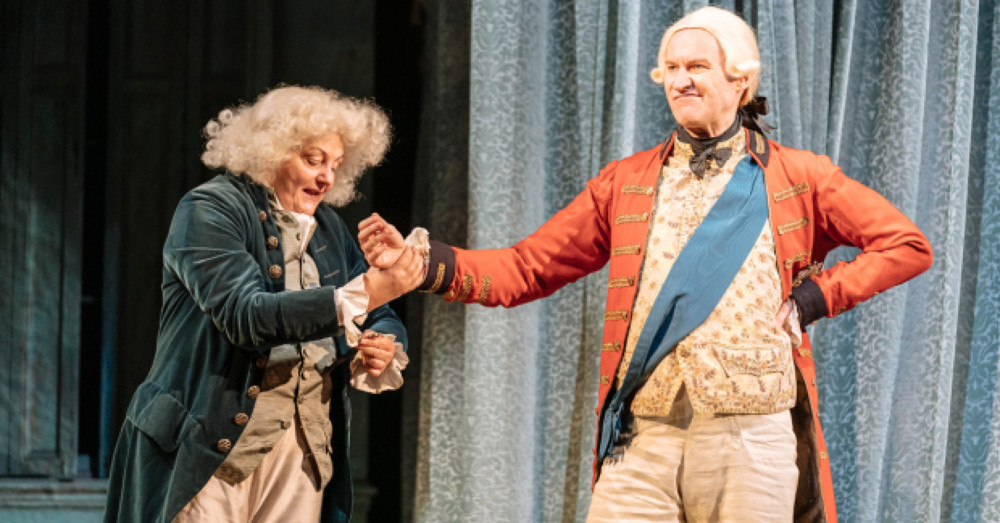

Whether an actor or anyone else, when our environment is not what we believe it should be, people feel uncertain. Between COVID disruptions and civil rights protests and, as we are concerned here, theatre’s current state; uncertainty is where we’ve found ourselves. As we march across our pandemic choked reality, these disruptions will lead to change. While live theatre grows distant and we settle for its digitized shadow, I hope The National Theatre, and others like them, seize this opportunity to expand theatre’s visibility to fresh audiences. Audiences who might have otherwise never thought to see a play. Those are the voices our theatre is missing. And as new, diverse voices collect, their perspectives will contribute to a greater art form. A more precise mirror for more people. A finer reflection to help instill greater compassion and enact more precise social change than what may have been imagined before.
The National Theatre’s Production of The Madness of George III streams on YouTube through June 18. 2hrs 10mins. with a very brief intermission. https://www.youtube.com/watch?v=fofiKCV9wGc
Photos courtesy of The National Theatre Live
A Brief Epilogue of a Brief Series
Before the pandemic, Broadway’s streak of financial gains seemed never ending. Audiences are well suited for catchy commercial spectacle, but theater’s great obstacle lies in the fact that so many people around the world haven’t the slightest idea what theater is as an art form. And the majority have no reason to care. But they all watch film.
I began this series optimistically, happy to work through any meaning I might find from an important cultural leader. A National Theatre capable of bursting through accessibility barriers to introduce theater’s true nature to quality-seeking mainstream audiences. Theatrer as one artistic masterpiece on top of another artistic masterpiece on top of another artistic masterpiece and so on. Our world’s greatest writing and acting under a unique discipline of direction and design.
Yet, for some reason, our western leader in theater has curated productions more concerned with commercial magnetism, often flaunting celebrities and massive expenditures, over a responsibility to challenge audiences. Ignoring potential viewers readily primed from a golden age of refined streaming television.
With production companies stalled, quality content is suddenly in short supply. Our dissatisfying Neflix watchlists are thinning. Recorded theatre is uniquely positioned to prove itself as a fresh, fulfilling and accessible mainstream artform. Instead, we are actively reinforcing the general public’s long-held deadly opinion: Theater is a second-rate alternative to film. We squander our opportunity to blow people’s minds and we find ourselves encouraging ignorant assumptions.
The dense history of modern recorded theatrical productions is unbearably inspiring. But we play down to our audiences. Disrespecting them by force feeding TV personalities and patting ourselves on the back for having acquired a superhero patron magnet to pay our bills. Thus, perpetuating our compromising approach to art—limiting our ability to create genuine art over counterfeit art. Our profession has evolved over a period of more than 2400 years. Film has been around for a bit over 100. HBO wouldn’t do this. Cannes wouldn’t do this. Criterion wouldn’t do this. Why should The National Theatre of London?


